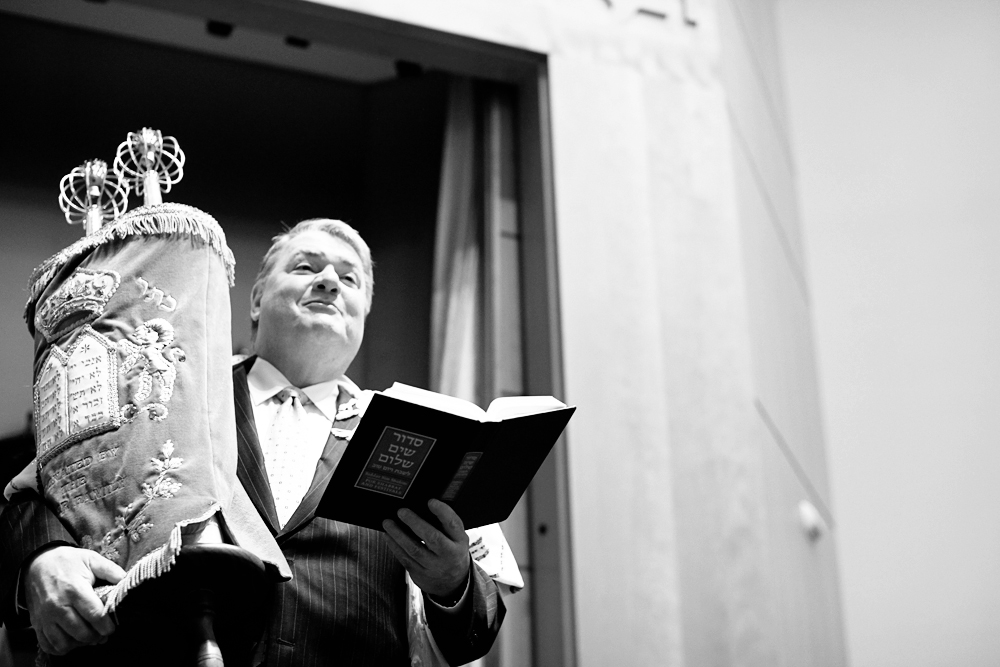A Tribute to Cantor Jacob Mendelson
The following sermon was delivered by Rabbi Michael Goldman of Temple Israel Center on the occasion of my last Shabbat.
Probably everyone here has some sort of memory of a musical conversion experience. The first time—or maybe it was the hundredth time—you heard a certain piece or genre of music or artist. Where and how these epiphanies happen varies from person to person, depending on our musical education. But regardless of our background, these moments open up something for us, something greater than the music itself.
I was a white kid in suburbia in the late 70’s, and pop music had hit a low point. The Beatles had long disbanded. The Rolling Stones were copying themselves. You still heard that old, good music on the radio, but for the most part the arena rock stuffed the airwaves: Men in lycra and velveteen, with enormous coiffures, singing in falsetto about unicorns and wars among elves. Every song had several thematic changes, culminating in a four-minute face-melting guitar—or flute—or pipe organ—solo. That music had a way of making you feel simultaneously overwhelmed and lacking; it left you with the suspicion that the experience would be more meaningful, more total, if only you were high on magic mushrooms.
Then one night, I was at a party thrown by one of my older sister’s friends. She had just come back just come back from New York, and pulled out a record with a grainy black and white jacket that looked like it had been mimeographed. You could barely make out the image of four undernourished looking lads in torn jeans, t-shirts and 50’s style leather jackets, like a cross between James Dean and Scooby Doo. Above their heads was a banner that looked like a sign at a discount store, proclaiming: The Ramones.
“One Two Three Four…” The Ramones were fast, loud and to the point. No song lasted more than three minutes, no solos. The sound was low-fi; if the big hair bands were meant to be heard in stadiums or through $200 Sennheiser headphones, the Ramones were meant to be be played in a high school cafeteria. Their arrangements were deliberately, idiotically simple; they had a rule that no song could contain more than five chords. The lyrics were aggressive, direct, accessible and silly, the stuff of teenage angst and late-night TV: “All the girls are in love with me / I’m a teenage lobotomy!”
Everyone at the party began jumping up and down like crazy, screaming, “Lobotomy! Lobotomy!” We felt free and we didn’t even know why.
What The Ramones, four lower-middle-class Jewish kids (the front man, Joey Ramone, was born Jeffry Hyman) from broken homes in Forest Hills Queens, and what punk rock in general, taught my generation was that we had the authority to be creative. The Ramones created a sound that was intentionally imitable. They played on instruments that sounded like they were bought at a thrift store, and in clothes that looked like they came from a dumpster. In the course of a single song at a party, we all realized that we didn’t have to look and dress like Prince Valiant, or to own expensive sound equipment, to be in a band. We didn’t have to be mere consumers of music; we could produce it, too, and it didn’t have to sound a certain way.
Punk rock also taught us that it was okay to be emotional. It was okay to scream, to be grumpy, to be silly, to be idiots. It was okay to be adolescent. To be human.
The second moment of conversion I’d like to tell you about wasn’t really a single moment, but an accretion of hundreds, over the course of years, especially this past four, in the presence of Cantor Mendelson and with his son, Danny. If you must take one of those moments as a paradigm, remember the last moments of Neilah.
Now Hazzanut, the cantorial tradition that came out of Eastern Europe, does not sound like punk rock. But some of the reasons that both these musical forms appeal to me are the same (Jackie, I want you to think about what I’m about to say the next time you put on a Ramones record).
One point that hey have in common is what they say about the idea of authenticity. The Ramones were totally aware that their music sounded recycled. What’s recycled is neither entirely old, nor entirely new, but a little bit of both. The arena rock of their day, waffled between trying to sound totally new, like synthesizer music from outer space, or else like mysterious ancient music from some mythical Celtic royal court. The Ramones wanted to sound like a cheap Buddy Holly, like the girl groups and the garage bands of the 60’s. They didn’t mind being derivative. That was the whole point—to sound like a trip to the record department at Salvation Army, with scratches and blips intact.
Hazzanut has a traditional central reference point, the liturgy. It also has the five or so notes of the ahavah rabah scale. And there are the old tunes, the misinai tunes, which go millennia deep into tradition. But the fact that those tunes are called misinai shows that they are the exception to the rule. Hazzanut’s appetite for the nontraditional is huge. Hazzanut and hazzanim are omnivorous. You can hear in it the influence of classical music, Slavic folk music, the Central European art song and now, Sondheim and jazz—music that in itself, influenced by hazzanut.
The best music is often not the pure product, the indigenous sound (does that really exist?) but the hybrid, the Afro-Semitic Experience, the Zion 80—(to mention one other excellent local group, who reinterpret Carelbach melodies to Nigerian Afrobeat arrangements). Hazzanut is not just an Eastern European past, not just a nostalgia trip, but a place where that past meets the present, where East meets West, where high culture meets the street, where continents collide.
Another thing is that hazzanut and punk are about feeling. Sometimes this is hard to understand because punk rock is at its best when it’s really bad, and hazzanut, when it’s bad, is just bad. Hazzanut really is an art form, while punk is only debatably one. But I recently put the question to a friend, James Loeffler, professor of ethnomusicology at the University of Virginia. I gave him the task: “Punk. Hazzanut. Fifteen seconds. Go!” Here’s what he said:
“Hazzanut may sound florid, baroque, operatic, but its also unadorned… Both are raw and drill down to essence of human emotion in sound.”
There’s a scene in A Cantor’s Tale, the movie that was made about Jackie, where he’s teaching young cantorial students how to sing hazzanes. These students are clearly technically gifted; they’re trained in opera, in choral music, in folk and in Broadway. But can they feel it in their kishkes? Jackie sits with them at the piano, a little frustrated. They’re hitting the right notes, but they’re not yet singing it like they mean it. It’s not only about virtuosity; it’s also about expressing life experience; it’s about accessing pain and joy, the places of darkness and light. It’s about performance. But it’s also about God. And it’s also about the id.
Avinu malkeinu is in the imperative. Khoneinu va’aneinu! Be gracious to us, answer us! Are you listening? We’re demanding! Our liturgy isn’t just the word of God descending to our receptive ears. More than that, it’s us pleading with God, bewailing mistreatment and misfortune, demanding better treatment. Even if you don’t scream literally, doing this well takes a kind of inner screaming. There’s a story by the Yiddish writer Yehudah Leyb Peretz called “The Missing Melody.” It’s a story about a master hazzan, in which he compares “scholars,” the people people who have the technical skills, but who don’t feel the melodies, to craftsmen who can make an instrument but can’t get a true sound out of it:
“The scholars are no more than mere workmen who make the musical instruments and repair them but know nothing about playing. This is why they cannot enter the palace… A great craftsman may sometimes put an instrument to his lips, but the sound is cold and soulless.”
As I once heard Jackie say—and this may be in the film—the unique thing about hazzanut bears the distinction of wing one of the only sophisticated vocal art forms where you don’t have to put energy into sublimating your own emotional state; rather, your feelings are your vehicle toward making it good.
In the Talmud tractate Ta’anit, the question is asked: What sort of person should the congregation send up to the ark to be the shaliakh tzibur—the one who pleads before God in prayer, to rescue them from a drought? Rabbi Yehudah says—in words you may remember from the hineini prayer because some of them made their way into it—it should be someone pirko naeh vekolo arev uvaki likrot baTorah—who is skilled in chanting, who has a pleasant voice and is learned in Torah. In other words, a person has to have skills. But then Rabbi Yehudah goes on to say that a person also has to be metupal v’ein lo.—a difficult phrase. Rashi takes it to mean: Yesh lo tefeilim ve ein lo mah lihitparnes—Someone with lots of children and no way to support them. In other words, someone who can sing the blues (Executive committees: do not let this piece of rabbinic wisdom be a guide for writing your cantor’s contract).
There’s a bit of irony here, of course: Sometimes we need someone with some expertise to show us the way to feel. In the ancient world mourners would hire mekonenot, women who were specially trained to wail. They would open the floodgates for the mourners, and the mourners would get carried along by the current.
These days, in our scrupulous egalitarianism, we sometimes think that all we need are a set of great congregational melodies. If we all sing together, if we all can master the same tunes, we’ll achieve that thing we all crave: that sense of home, of belonging, of harmony, of satisfaction, an end to our existential loneliness. I think that this can happen with congregational singing. Sometimes.
But just as often—probably more often—we get to that point, the point of forgetting our loneliness, when we watch someone else, an individual, laying bare their own loneliness, before God and before us. Such a person must be a performer, someone with stamina, with a sense of timing and a sense of rhythm, a person who can hold a tune and who is attuned to our emotions.
Jackie, on that Ramones album there was a line: “Jackie is a punk.” From now on, when I hear it, I’ll think of two moments. One, pogoing in a friend’s living room to music brilliantly simple and liberating, a song 1’33’’ long—that it made us all realize that we had forgotten what music can be. The other is you at Neilah, one more Avinu malkeinu. By the way, what could be a better punk rock uniform than a kitl—the bathrobe we’ll be buried in when we die? You’ve been screaming at God for 25 hours. You’ve been messing with our heads for that long, too. A continuous 25 hour song. But at that moment it feels like we’ve been there for like 1’33’’. And you’re still on key.
You’re a rock star, baby. Jackie, you’re a punk.




